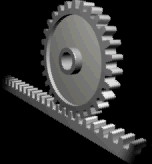Pinion
(Redirected from Pinions)
Pinion refers to the smaller of two gears in a gear set or the smaller gear that engages with a larger gear or rack in a mechanical system. In many applications, the pinion transfers motion and force from a power source, such as an electric motor or internal combustion engine, to a larger gear or mechanism, thereby reducing speed and increasing torque in the process. This principle is widely utilized in various mechanical systems, including automobile transmissions, clock mechanisms, and other machinery.
Function and Application[edit | edit source]
The primary function of a pinion is to transmit power from the driving component to the driven component in a mechanical system. It does so by meshing with a larger gear or rack, which results in a change in the speed and direction of the force transmitted through the gears. The ratio of the number of teeth on the larger gear to the number of teeth on the pinion determines the magnitude of this change, a concept known as the gear ratio.
In automobiles, the pinion is a critical component of the steering system, where it engages with a steering rack to convert the rotational motion of the steering wheel into the lateral motion required to turn the wheels. Similarly, in the differential of a vehicle, the pinion engages with a ring gear to distribute power from the engine to the wheels, allowing them to rotate at different speeds during turns.
In clocks and watches, pinions are integral to the timekeeping mechanism, where they interact with gears to control the movement of the hands and the operation of other features, such as chimes or calendars.
Materials and Manufacturing[edit | edit source]
Pinions are typically made from metals such as steel or brass, depending on the application's requirements for strength, durability, and resistance to wear. The manufacturing process involves precision machining and finishing techniques to ensure that the teeth of the pinion mesh smoothly and accurately with the corresponding gear or rack. This precision is crucial for the efficient and quiet operation of the gear set.
Maintenance and Issues[edit | edit source]
Proper lubrication and alignment are essential for the longevity and performance of pinions and the gear sets they are part of. Lack of lubrication can lead to increased friction, wear, and ultimately, the failure of the pinion or the larger gear. Misalignment can cause uneven wear and noise. Regular inspection and maintenance are necessary to prevent these issues and to ensure the smooth operation of the system.
Conclusion[edit | edit source]
The pinion is a fundamental component in many mechanical systems, playing a crucial role in transmitting power and motion between components. Its design and manufacturing require precision and care to ensure that it functions correctly within the gear set, contributing to the overall efficiency and reliability of the system.
Search WikiMD
Ad.Tired of being Overweight? Try W8MD's physician weight loss program.
Semaglutide (Ozempic / Wegovy and Tirzepatide (Mounjaro / Zepbound) available.
Advertise on WikiMD
|
WikiMD's Wellness Encyclopedia |
| Let Food Be Thy Medicine Medicine Thy Food - Hippocrates |
Translate this page: - East Asian
中文,
日本,
한국어,
South Asian
हिन्दी,
தமிழ்,
తెలుగు,
Urdu,
ಕನ್ನಡ,
Southeast Asian
Indonesian,
Vietnamese,
Thai,
မြန်မာဘာသာ,
বাংলা
European
español,
Deutsch,
français,
Greek,
português do Brasil,
polski,
română,
русский,
Nederlands,
norsk,
svenska,
suomi,
Italian
Middle Eastern & African
عربى,
Turkish,
Persian,
Hebrew,
Afrikaans,
isiZulu,
Kiswahili,
Other
Bulgarian,
Hungarian,
Czech,
Swedish,
മലയാളം,
मराठी,
ਪੰਜਾਬੀ,
ગુજરાતી,
Portuguese,
Ukrainian
Medical Disclaimer: WikiMD is not a substitute for professional medical advice. The information on WikiMD is provided as an information resource only, may be incorrect, outdated or misleading, and is not to be used or relied on for any diagnostic or treatment purposes. Please consult your health care provider before making any healthcare decisions or for guidance about a specific medical condition. WikiMD expressly disclaims responsibility, and shall have no liability, for any damages, loss, injury, or liability whatsoever suffered as a result of your reliance on the information contained in this site. By visiting this site you agree to the foregoing terms and conditions, which may from time to time be changed or supplemented by WikiMD. If you do not agree to the foregoing terms and conditions, you should not enter or use this site. See full disclaimer.
Credits:Most images are courtesy of Wikimedia commons, and templates, categories Wikipedia, licensed under CC BY SA or similar.
Contributors: Prab R. Tumpati, MD


